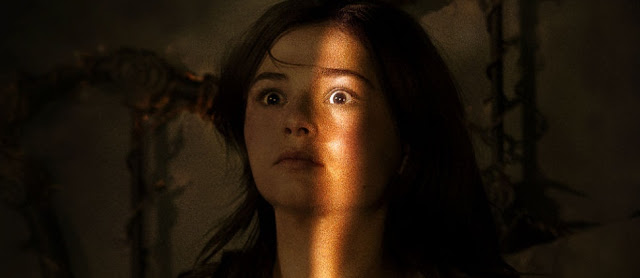The collaboration between director James Wan and screenwriter/actor Leigh Whannell is responsible for some of the most fertile horror flicks in recent memory. Their first, the blood-soaked Saw (2004), about a dying serial killer who preys on those ungrateful of being alive, spawned six sequels. Dead Silence (2007) was a disappointment, With Insidious (2011), they set up a new franchise that has now recently become a trilogy. Surprisingly enough, this one is relatively bloodless, more akin to Paranormal Activity (2007) and The Exorcist (1973), it relies almost entirely on darkness and ghoulish figures crawling out of it to scare its audiences. Wan directed the first two films, but because of a scheduling conflict, Insidious: Chapter 3 became Leigh Whannell's first directorial effort.
This time, Whannell sets the story a few years before the Lambert haunting and before Elise Rainier (Lin Shaye) was the strong and confident psychic we knew her to be. We follow the struggle of Quinn Brenner (Stephanie
Scott), a high school senior and aspiring actress who lives with her father (Dermot Mulroney) and her younger brother (Tate Berney). Quinn has been trying to connect with her deceased mother ever since she died from breast cancer a little more than a year prior.
That's when she asks for help from a recluse psychic with a familiar face, to us anyways. Living in her poorly lit house with her dog and the
memories of her husband. Elise accepts to
converse with Quinn for a moment, but quickly shuts her off and tells her she swore never to get back into that business, and for good
reasons. She leaves her only with a warning: "If you call out to one of the
dead, all of them can hear you."
A malevolent entity in the shape of a man who can't breathe then starts to torment and terrify Quinn, and when Elise finally agrees to help, she has to face her own demons,
literally. And Lin Shaye is then given a rarely layered role for an
actress in a horror movie, going from an insecure and fearful hermit to a
courageous and capable ghost hunter. She's definitely the most
interesting character the trilogy had to offer us and giving her more
room to shine was a very good decision. Her performance is the best thing about this movie.
At one point in the film, Quinn is hit by a car, leaving her with two broken legs. She is then bound to a wheelchair. And her being unable to move or defend herself from her otherworldly assailant provide much of the tension. Film critic Christie Lemire pointed out the resemblance with Alfred Hitchcock's Rear Window (1954), and she's right. All Quinn can do is watch and wait for terrible events to occur - just like us
Whannell also drew inspiration from respected classics such as Poltergeist (1982) and The Shining
(1980). But without forgetting what made the first two films so popular
among it's target audience in order to give them what they wanted
without necessarily repeating himself. And so every Insidious
film is fundamentally different from the others while staying true to
the characters and respecting the rules of the universe they're
developing into. They are also loyal to the shadowy and unapologetic
visual style James Wan first established with his cinematographer John
R. Leonetti in the first Insidious. A trademark that can also be found all over Wan's excellent The Conjuring (2013), and it's mediocre spinoff Annabelle (2014), which was directed by Leonetti.
That being said, imagine a scene that takes place in a haunted room, if it's from a horror film, the director will first try to convince you nothing is there. Yet he doesn't want you to know you're being shown the room, otherwise you might get suspicious. So he might try to distract you with something, it's often just characters talking casually. Then, you might be shown some specific parts of the room subconsciously one or two more times, but they will always look safe. Now your guard is down and before you know it, a shadow passes by. Add some loud eerie sound at that very moment and you've got yourself a jump scare. That's one of the most generic and overused scare formulas ever, and I can't think of any effective horror film that doesn't use it at least once. The problem is not using it as much as using it wrong because scares must be earned and remembered. For instance, a cat jumping out of a closet might make you jump for a second, but only out of plain reflex, there is no fear in that. On the other hand, the ghosts of murdered twin sisters pleading you to come play with them forever and ever and ever could leave a lingering sting.
Some clever moments in the Insidious films, especially the first one, will lead you to think these filmmakers know this, but most of the time, you can tell in advance if a scene is played out for character development, or just to scare the living daylights out of you. And while great movies manage to do both at the same time, here it's often the second option.
Whannell is known for adding chilling twists in his stories, and I believe they work well because they involve details that were hiding in plain sight all along. In Saw (2004), the character you assumed to be dead the entire time starts talking at the end. And look no further than Dead Silence (2007) to find the exact opposite. The Insidious films also have their share of twists and turns, but in a very interesting way, and because the three films work better when watched as a whole, they serve to make the other films even more horrifying you originally thought they were. Why? Oh, I wouldn't dare to tell...



No comments:
Post a Comment